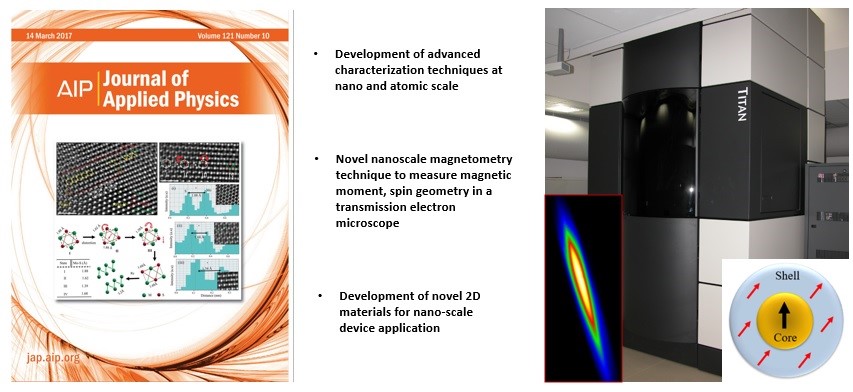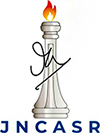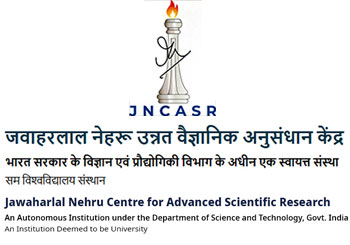Aberration corrected high resolution electron microscopy group
Our research is primarily based on aberration corrected transmission electron microscopy and high resolution electron energy loss spectroscopy (HREELS). Besides general advanced characterization of materials, we are involved in quantitative HRTEM imaging, developing techniques for nano and atomic length scale probing of electronic structure of materials. We work in a FEI TITAN aberration corrected microscope, and also perform first principle based calculation using WIEN 2k.
We are also involved with basic aspects of epitaxial thin film growth of wide band gap semiconductors, 2D materials and their heterostructures in a PLD.
Between Year 2020-2022
-
Image simulation in high resolution transmission electron microscopy considering atom as an electrostatic interferometer
Ref:Journal of Physics Communications 5 (8), 085004 (2021)
An alternative approach to image simulation in high resolution transmission electron microscopy (HRTEM) is introduced after a comparative analysis of the existing image simulation methods. The alternative method is based on considering the atom center as an electrostatic interferometer akin to the conventional off-axis electron biprism within few nanometers of focus variation. Simulation results are compared with the experimental images of 2D materials of MoS2, BN recorded under the optimum combination of third order spherical aberrationμm and defocus1, 4, and 8 nm and are found to be in good agreement.


- Insights and alternative proposals on the phase retrieval in high resolution transmission electron microscopy
Alternative reconstruction method is proposed on retrieving the object exit wave function (OEW) directly from the recorded image intensity pattern in high resolution transmission electron microscopy (HRTEM). The method is based on applying a modified intensity equation representing the HRTEM image. A comparative discussion is provided between the existing methodologies involved in reconstruction of OEW, off-axis electron holography and the present proposal. Phase shift extracted from the experimental images of MoS2, BN and ZnO are found to be in excellent agreement with the theoretical reference values. Additionally, it is shown that the Fourier series expansion of diffraction pattern is effective in retrieving the isolated and periodic image functions of certain form directly. However, for aperiodic object information e.g., defects, dopants, edges etc., the first method works in entirety.




Before 2020
- Quantitative characterization of magnetism at nano and atomic length scale
Development of quantitative electron magnetic circular dichroism techniques (EMCD) at nano scale in an aberration corrected transmission electron microscope. The work also involves development of a phenomenological model to extract magnetic moments quantitatively. The technique and method developed can extract element specific nano scale magnetic moments both spin and orbital moments in magnetic materials.
Refs.
- Effect of Bloch wave electron propagation and momentum-resolved signal detection on the quantitative and site-specific electron magnetic chiral dichroism of magnetic spineloxide thin films
B Loukya, DS Negi, K Dileep, N Pachauri, A Gupta, R Datta, Physical Review B 91 (13), 134412, 2015.
- Development of quantitative magnetic order and spin canting measurement at atomic plane resolution by HREELS
A soft experimental technique was developed part of this work which can give information at one atomic plane resolution. The work extracted magnetic order differences between the core and surface of magnetic nanocrystals of CuCr2S4. Surface spin canting geometry has also been revealed in CoFe2O4 and Fe3O4 nanocrystals. by the same technique with better information compared to a recently developed spin polarized neutron technique.
Refs.
- Surface spin canting in Fe3O4 and CoFe2O4 nanoparticles probed by high resolution electron energy loss spectroscopy
D.S. Negi, H Sharona, U Bhat, S Palchoudhury, A Gupta, R. Datta, Physical Review B 95, 174444, 2017 - Spatially resolved quantitative magnetic order measurement in spinel CuCr2S4nanocrystals
DS Negi, B Loukya, K Ramasamy, A Gupta, R Datta, Applied Physics Letters 106 (18), 182402, 2015
- Quantitative atomic resolution imaging by HRTEM and atomic resolution off-axis electron holography
State of the art advanced aberration corrected HRTEM and atomic resolution holography (double biprism) techniques have been utilized to count both Zn and O atoms along high symmetry crystal orientation of ZnO lattice from the image. It will be extended further to develop the methods and expand the scope of the techniques in materials science.
Refs.
- Quantitative counting of Zn and O atoms by atomic resolution off-axis and in-line electron holography
U Bhat, R Datta, Journal of Applied Physics 125 (15), 154902, 2019
- Epitaxial thin film growth of 2D materials and their hetero structures
The epitaxial growth of 2D material of MoS2, WS2, ReS2 and their hetero structures with BN have been demonstrated by PLD technique. Control over layer number and unique optical property in the heterostructure system are obtained. A strong emission at 2.3 eV is obtained due to coupled transition between BN valence band to MoS2/WS2/ReS2 conduction band.
Refs.
- Substrate induced tuning of compressive strain and phonon modes in large area MoS2 and WS2 van der Waals epitaxial thin films
Rajib Sahu, Dhanya Radhakrishnan, Badri Vishal, Devendra Singh Negi, Anomitra Sil, Chandrabhas Narayana, Ranjan Datta, Journal of Crystal Growth 470, 51-57, 2017 - Distinct photoluminescence in multilayered van der Waals heterostructures of MoS2/WS2/ReS2 and BN
U Bhat, R Singh, B Vishal, A Sharma, H Sharona, R Sahu, R Datta, phys. status solidi B, 1700691, 2018
- Detailed structural elucidation of 2D alloy system
Relative structural stability (1T, 1Td, and 2H) and atomic organizations in ReS2-MoS2, and ReS2-WS2 alloy system have been elucidated by advanced HRTEM imaging technique and density functional theory based calculation.
Refs.
- Rich diversity of crystallographic phase formation in 2D RexMo1 – xS2 (x < 0.5) alloy
H Sharona, B Vishal, U Bhat, A Paul, A Mukherjee, SC Sarma, SC Peter, R Datta, Journal of Applied Physics 126 (22), 224302, 2019. - Nature of low dimensional structural modulations and relative phase stability in RexMo(W)1-xS2 transition metal dichalcogenide alloys [COVER ARTICLE]
R Sahu, U Bhat, NM Batra, H Sharona, B Vishal, S Sarkar, S Assa Aravindh, SC Peter, Iman S Roqan, PMFJ Costa, Ranjan Datta, Journal of Applied Physics 121 (10), 105101, 2017
- Metastable wurtzite BN epitaxial thin film
This was an accidental discovery of stabilizing metastable wurtzite BN during thin film growth of BN in a PLD. The phase got stabilized under unusual low pressure and temperature condition which otherwise would require explosive temperature and pressure condition to stabilize the phase.
Ref.
- Chemically stabilized epitaxial wurtzite-BN thin film
B Vishal, R Singh, A Chaturvedi, A Sharma, MB Sreedhara, R Sahu, Usha Bhat, Upadrasta Ramamurty, Ranjan Datta , Superlattices and Microstructures 115, 197-203, 2018
There are numerous other contributions in general characterizations in materials science e.g., dark diffused contrast in CoO and NiCo2O4 spinel thin films.


- Back to previous page
- |
-
Page last updated date:21-05-2025 03:19 PM























